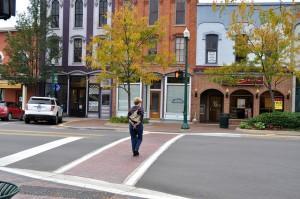 To be a Walker is to walk just about everywhere you go. In some cities, like Manhattan or DC, this is easy to accomplish because the cities are dense. That is, the dry cleaner is near the daycare, which is near the Trader Joes, and all in a days walk, all needs can be accomplished by foot. We like Walkers because the Walker lifestyle benefits the earth (by virtue of not being in a car, Walkers are not emitting greenhouse gases) and provides health benefits to the Walker himself. But dense and mixed environments put destinations close together; by that fact alone, people walk less in these communities, questioning their potential for weight related health benefits. Can the built environment promote health if health returns diminish as density increases?
To be a Walker is to walk just about everywhere you go. In some cities, like Manhattan or DC, this is easy to accomplish because the cities are dense. That is, the dry cleaner is near the daycare, which is near the Trader Joes, and all in a days walk, all needs can be accomplished by foot. We like Walkers because the Walker lifestyle benefits the earth (by virtue of not being in a car, Walkers are not emitting greenhouse gases) and provides health benefits to the Walker himself. But dense and mixed environments put destinations close together; by that fact alone, people walk less in these communities, questioning their potential for weight related health benefits. Can the built environment promote health if health returns diminish as density increases?
A blogger out in Manhattan recently tracked his miles using an iphone app and found that he, a self-declared Walker, walked a lot, but not very far. He found that even though he went out of his way to walk, he never covered enough distance to burn off a sweetened ice coffee (should he drink those, he clarified). The author concludes that while we should build walkable communities because people like them, we should be wary of the idea that the built environment can do much to combat obesity.
Only it can.
Health returns do not diminish as density increases; if a city is designed right, the health returns can multiply. Sure, one walks less in a mixed-use, dense community, but pure walking was never thought to be the answer to the obesity crisis– and planning and public health advocates need to be sure to stay away from such a narrative.
There are a host of reasons why walking — even short distances– in dense, mixed use communities is crucial to reducing obesity. For starters, it changes the norm. When everyone walks, non-walkers feel compelled to become Walkers, thus starting them on a path toward healthier behaviors. A Walker is also likelier to hop on a bike or bus than a Driver, and soon might not just bike for transportation but recreational purposes as well. Communities that support walking support a whole range of pro-health behaviors and lifestyles– behaviors that further promote sustainability.
And by thinking about how we design urban spaces, we can take steps to ensure that walkable communities actively encourage healthy behaviors. Good urban design can encourage walking, biking, running and even healthy eating. This is the premise, for example, behind the Center for Active Design in New York City. The Center– an endeavor of Mayor Bloomberg– seeks to reduce obesity and chronic disease through the design of buildings, streets and neighborhoods. As the Center explains, our streets can support playing; taking the stairs is a way to burn more calories (and wider staircases even encourage stair usage); and office buildings can include rubber tracks to encourage walking meetings. Other neat, pro-health community design projects include the “Red Swing Project,” which transforms unexpected places into playgrounds; the “Urban Farming Food Chain,” which transforms walls into “edible” walls that grow fresh fruits, vegetables and herbs; and mobile dumpster pools in NYC.
Walking may ultimately be limited in dense places, but that’s only half the store. In and of itself, walking is an important behavior, one that serves to encourage more health. And dense places, if designed with health in mind, can actively reduce obesity. If the goal is to get everyone out of cars and turn people into Walkers, walking is an excellent place to start.




